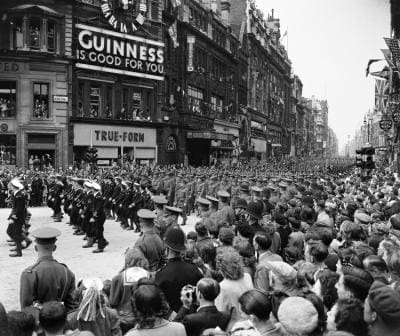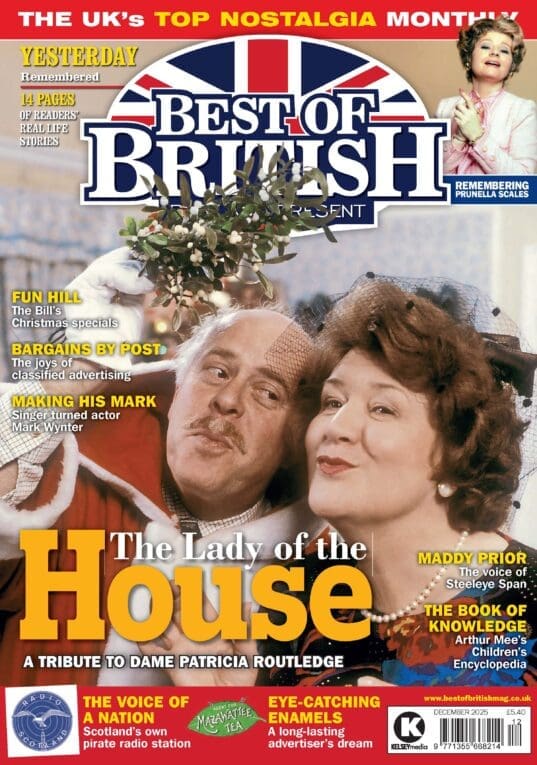On 8 June 1946, George VI sent this message to every schoolchild in Britain:
“To-day as we celebrate victory, I send this personal message to you and all other boys and girls at school. For you have shared in the hardships and dangers of a total war and you have shared no less in the triumph of the Allied Nations.
I know you will always feel proud to belong to a country which was capable of such supreme effort; proud, too, of parents and elder brothers and sisters who by their courage, endurance and enterprise brought victory. May these qualities be yours as you grow up and join in the common effort to establish among the nations of the world unity and peace.” George R.I.
Enjoy more Best of British Magazine reading every month.
Click here to subscribe & save.

On the same day, London saw the official Victory Celebrations comprising a military parade and a massive floodlight and fireworks display. Both the German axis and the Japanese had finally been defeated and Britain and her allies (with one or two notable exceptions) joined in the parade.
The Illustrated London News, Victory Parade Number, on 15 June 1946 said:
“A specially warm tribute of applause was forthcoming from the crowds all along the Victory Parade route as the troops of our Allies marched by; and as they passed the saluting base, the war leaders grouped there beside the royal dais made grateful acknowledgement to the flags of countries whose men had fought side by side with our men. Headed by the Guards band the representatives of Allied forces were led by the United States, whose contingent included the Marine Corps. After the American contingent came the troops of China, occupying the place in the procession originally reserved for USSR, and behind them came contingents with a bewildered variety of flags and uniforms – France, Belgium, Brazil, Czechoslovakia, Denmark, Egypt, Ethiopia, Greece, Iran, Iraq, Luxembourg, Mexico, Nepal, Netherlands, Norway and Transjordan. Apart from the USSR, only Poland and Yugoslavia were not represented among our Allies….” More on that later…
Escorted by the Household Cavalry the King (in Royal Naval uniform) and Queen, Princess Elizabeth and Princess Margaret left Buckingham Palace at 10.10am in the State Landau and took 47 minutes to reach their “saluting base” on the Mall where they were entertained by the Massed Pipers of the Scottish and Irish Regiments
Somewhat vaingloriously perhaps, the Chiefs of Staff and Supreme Allied Commanders then led the 21/2 hour parade, some in armoured cars. They were followed by a four mile column of transport, beginning somewhat oddly but traditionally, with the Senior Service, the Royal Navy with their Amphibious Jeeps, Weasels, DUKW’s, Mobile Wireless Telegraphy Units, Aircraft Refuellers and Mobile Sick Bays. Then came the RAF, with a vast array of equipment including Radar Vehicles, Fire Tenders, a Dental Caravan towed by Air Traffic Control Towing Car, loaded Bomb Tenders, a Mobile Workshop, and an “Airborne Lifeboat on an Aircraft Transporter”.
The civilian services then offered police cars, buses and many more vehicles, while the Army presumably stole the show with their tanks and tank carriers, armoured cars, flails, jeeps and mounted guns.
The subsequent column of men on foot was led by the alphabetical allies – Belgium, Brazil, Czechoslovakia, Denmark, Egypt, Ethiopia, Greece, Iran, Iraq, Luxembourg, Mexico, Nepal, Netherlands, Norway, Poland, Transjordan and Yugoslavia.
Then came what were still British Empire units (many listed under their former names) from India, Burma, Nigeria, Gold Coast, Sierra Leone, Gambia, Kenya, Uganda, Tanganyika, Nyasaland, Northern Rhodesia, Zanzibar, British Somaliland Aden, Bermuda, Ceylon, Cyprus, the Falklands, Gibraltar, Hong Kong, Malaya Bahamas, Barbados, British Guiana, British Honduras, Jamaica, Leeward islands, Trinidad and Tobago, the Windward Islands, Fiji and western pacific, Mauritius, north Borneo, Brunei, Labuan and Sarawak, Palestine, St Helena, Seychelles, Basutoland, Bechuanaland, Swaziland and Malta.
Then came British servicemen and many civilians, led again by the navy.
A fly past of 300 aircraft was led by Douglas Bader – a scene celebrated in his biopic, Reach for the Sky. It included Hurricanes, Sunderlands, Lancasters, Mosquitos, Sea Mosquitos, Beaufighters, Firebrands, Seafires, Spitfires, Fireflies, Tempests, Meteors and Vampires
With the parade over, there were seemingly endless entertainments, mainly in London’s parks, including a “Nautical Orchestra”, Folk and ballet dancing by London school children, Community Singing, Scottish Pipers and Dancers, and Punch and Judy. As you like it played at the open air theatre in Regent’s Park (admission free, seat hire 6d).
At 10pm, as darkness fell, George VI and his family sailed down the Thames on the Royal barge to the Houses of Parliament to be greeted by a display of 80 searchlights and 41 aerial maroons. Some 500 loudspeakers blasted out the National Anthem and the lights and fireworks began. There was a searchlight, aquatic and firework display centred on the stretch of the River Thames between Hungerford and Vauxhall Bridges with the river lit up at Westminster and Lambeth Bridges. There was a coloured water display by 800 jets from eight fire floats and 20 specially equipped barges manned by firemen.
Handel’s Water and Firework Music blasted out, followed by fireworks and further searchlight displays. The RAF flew over again picked out by the now blessedly friendly beams of searchlights.
Finally at 11.45, some 50 magnesium shells were fired, accompanied by the playing of the National Anthem.
Steve Windsor
This article appeared in the June 2016 issue of Best of British.

